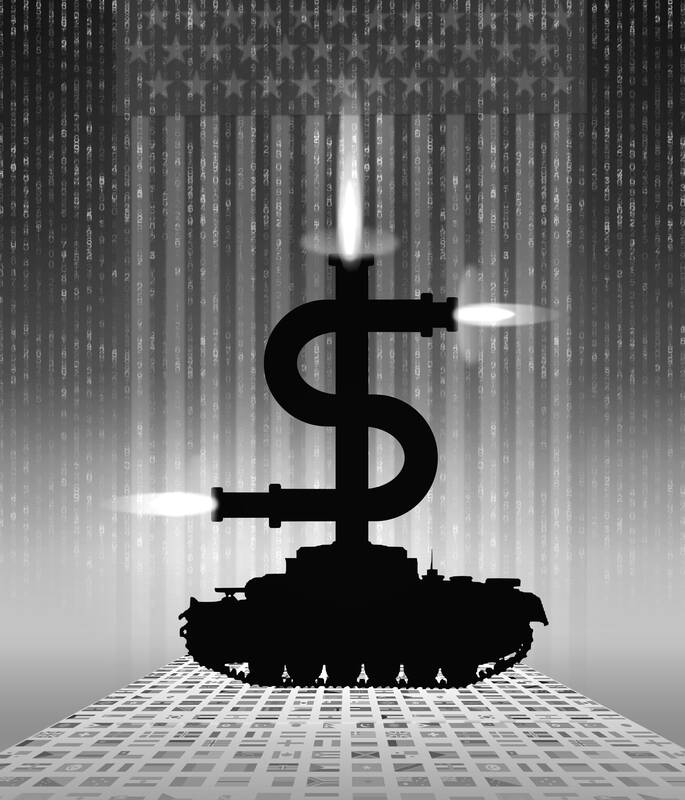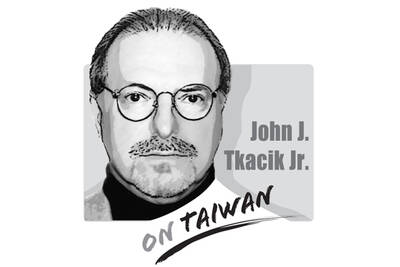All around the world, a backlash is brewing against the hegemony of the US dollar.
Brazil and China recently struck a deal to settle trade in their local currencies, seeking to bypass the greenback in the process. India and Malaysia in April signed an accord to ramp up usage of the rupee in cross-border business. Even perennial US ally France is starting to complete transactions in yuan.
Currency experts are leery of sounding like the Cassandras who have, embarrassingly, predicted the dollar’s imminent demise on any number of occasions over the past century. Yet in observing this sudden wave of agreements aimed at sidestepping the dollar, they detect the sort of meaningful action, however small and gradual, that was typically missing in the past.

Illustration: Yusha
For many global leaders, their rationales for taking these measures are strikingly similar. The greenback, they say, is being weaponized, used to push the US’ foreign-policy priorities — and punish those that oppose them.
Nowhere has that been more evident than in Russia, where the US has brought unprecedented financial pain to bear on Russian President Vladimir Putin’s regime in response to the invasion of Ukraine. The administration of US President Jor Biden has imposed sanctions, frozen hundreds of billions of dollars of Moscow’s foreign reserves and, in concert with Western allies, all but ousted the country from the global banking system. For much of the world, it has been a stark reminder of their own dependency on the dollar, regardless of what they think of the war.
That is the dilemma Washington officials face: By increasingly relying on the greenback to fight their geopolitical battles, not only do they risk denting the dollar’s preeminent place in world markets, but they could ultimately undermine their ability to exert influence on the global stage. To ensure long-term efficacy, sanctions are often better left as a threat and not actually carried out, said Daniel McDowell, author of Bucking the Buck: US Financial Sanctions and the International Backlash Against the Dollar.
“Now, a rational actor that knows it could potentially be in that situation in the future is going to prepare for that scenario, and it does make your coercive threats, your deterrent threats, less effective,” said McDowell, the director of undergraduate studies in the political science department at Syracuse University. “Maybe the change is marginal now, but even if it ultimately culminates in something that doesn’t dethrone the dollar,” it still matters in how it “can reduce American economic power.”
Undoubtedly, part of the shift away from the dollar is being orchestrated by China. Chinese President Xi Jinping (習近平) is seeking to carve out a bigger role for the yuan in the global financial system and his government has made expanding the currency’s use abroad a priority.
Yet much of the push is happening without Beijing’s involvement.
India — hardly a strategic ally of China — and Malaysia in April announced a new mechanism to conduct bilateral trade in rupees. It is part of a broader effort by the administration of Indian Prime Minister Narendra Modi — which has not signed on to the US-led sanctions campaign against Russia — to bypass the dollar for at least some international transactions.
A month later, ASEAN agreed to boost the use of member currencies for regional trade and investment.
South Korea and Indonesia just weeks ago signed an accord to promote direct exchanges of the won and rupiah.
Brazilian President Luiz Inacio Lula da Silva lashed out at the dollar’s dominance while visiting Shanghai in April. Standing at a podium surrounded by the flags of Brazil, Russia, India, China and South Africa, the so-called BRICS nations, he called on the world’s largest developing economies to come up with an alternative to replace the greenback in foreign trade, asking “who decided that the dollar was the [trade] currency after the end of gold parity?”
He was harkening back to the early 1970s, when the post-WWII accord — known as Bretton Woods — that had made the dollar the center of global finance was unraveling. The agreement’s collapse did little to blunt the dollar’s pre-eminent position. To this day, it serves as the world’s dominant reserve currency, which has juiced demand for US bonds, and allowed the country to run massive trade and budget deficits
The currency’s centrality to the global payments system also allows the US to wield unique influence over the economic destiny of other nations.
About 88 percent of all global foreign-exchange transactions, even those not involving the US or US companies, are in dollars, according to the most recent data from the Bank for International Settlements. Because banks handling cross-border dollar flows maintain accounts at the US Federal Reserve, they are susceptible to US sanctions.
While the campaign of financial punishments against Russia is the latest and most high-profile example, Democrat and Republican administrations have used sanctions on countries including Libya, Syria, Iran and Venezuela in recent years.
The Biden administration has averaged 1,151 new designations per year to the US Office of Foreign Assets Control’s list of specially designated nationals, according to a recent report from the Center for Economic and Policy Research. That is up from an average of 975 during the administration of former US president Donald Trump and 544 during former US president Barack Obama’s first four-year term.
“Countries have chafed for decades under US dollar dominance,” said Jonathan Wood, principal for global issues at consultancy Control Risks. “More aggressive and expansive use of US sanctions in recent years reinforces this discomfort — and coincides with demands by major emerging markets for a new distribution of global power.”
A representative for the US Department of the Treasury referred Bloomberg to comments that US Secretary of the Treasury Janet Yellen made in a mid-April interview with CNN, in which she acknowledged that “there is risk when we use financial sanctions that are linked to the role of the dollar that over time it could undermine the hegemony of the dollar.”
However, she said that the greenback “is used as a global currency for reasons that are not easy for other countries to find an alternative with the same properties.”
Market watchers agree. Even as a more countries look to lessen their reliance on the dollar, few expect its preeminent position in global trade and finance to be threatened any time soon.
For one, there is little sign any other currency could provide the same level of stability, liquidity and safety, they say. What is more, the vast majority of the US’ advanced-economy allies, making up more than 50 percent of global GDP, have shown little urgency in pivoting from the greenback.
The dollar has rallied versus the bulk of its major peers since the US stepped up its sanctions against Russia last year, a sign that any decline in its global status is likely to be a long, slow process.
“I cannot see any asset replacing the dollar as the dominant currency, not for the next generation,” said George Boubouras, a three-decade markets veteran and head of research at K2 Asset Management in Melbourne.
“Nothing comes close to the might of the US economy. China has its issues with aging demographics, and the euro has struggled to truly gain ground. The dollar will not be de-throned for the foreseeable future,” he said.
Still, the drumbeat of de-dollarization is continuing unabated in the developing world.
Pakistan is looking to pay for Russian crude imports in yuan, the country’s power minister said last month, while earlier this year the United Arab Emirates said it was in early stage discussions with India on ways to boost non-oil commerce in rupees.
Earlier this week foreign ministers from the BRICS group of nations discussed how the bloc can win greater global influence, including the feasibility of creating a shared currency.
“Without a doubt, de-dollarization is accelerating and will continue for years to come,” said Vishnu Varathan, head of economics and strategy at Mizuho Bank Ltd in Singapore. “The US made a calculated decision to use the dollar to inflict pain, and there’s likely to be long-term consequences.”

Somehow, US intelligence identified “the Houthis’ top missile guy” and pinpointed his exact location. At 1348 hours (Washington time), March 15, President Trump’s national security advisor Mike Waltz texted, “positive ID of him walking into his girlfriend’s building.” The unsuspecting Romeo entered. High above, the drone monitoring the building registered a flash. When the smoke cleared, Mr. Waltz texted, “…And it’s now collapsed.” RIP. The star-crossed “top missile guy” had been target number one in the now uproarious US Navy bombing campaign on that Sunday against the Yemeni rebels who have been holding the Red Sea hostage since October 19,
You wish every Taiwanese spoke English like I do. I was not born an anglophone, yet I am paid to write and speak in English. It is my working language and my primary idiom in private. I am more than bilingual: I think in English; it is my language now. Can you guess how many native English speakers I had as teachers in my entire life? Zero. I only lived in an English-speaking country, Australia, in my 30s, and it was because I was already fluent that I was able to live and pursue a career. English became my main language during adulthood
China on Tuesday, April Fool’s Day, began two-day joint-force military exercises around Taiwan, painting them as a “severe warning and forceful containment against Taiwan independence.” However, the exercises have again proven the country increasingly showcasing its military muscles to be a true “troublemaker.” Without prior notice, the Chinese People’s Liberation Army’s (PLA) Eastern Theater Command launched large-scale exercises codenamed “Strait Thunder-2025A,” deploying aircraft, drones and naval vessels including the Shandong aircraft carrier, as well as armed militia in the air and waters around Taiwan. The PLA claimed the military exercises were practice for precision strikes and a blockade to “close
Taiwan on Monday celebrated Freedom of Speech Day. The commemoration is not an international day, and was first established in Tainan by President William Lai (賴清德) in 2012, when he was mayor of that city. The day was elevated to a national holiday in 2016 by then-president Tsai Ing-wen (蔡英文). Lai chose April 7, because it marks the anniversary of the death of democracy advocate Deng Nan-jung (鄭南榕), who started Freedom Era Weekly to promote freedom of expression. Thirty-six years ago, a warrant for Deng’s arrest had been issued after he refused to appear in court to answer charges of